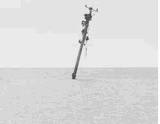False amber near Liepāja
In 1988, commanders at the Baltic War District ordered the destruction of some 500 phosphorous bombs that had been stored by the military since the end of World War II. According to regulations, the explosives were supposed to be dismantled, but it was decided instead to save time and effort and just blow the bombs up. This was done at the Pape airfield, which covered some 5,000 hectares.
The beach at Liepāja has been dangerous for more than 20 years because of a substance that the sea often washes up to the shore during spring and autumn storms. It is white phosphorous, and it is devilishly similar to amber. If someone picks up white phosphorous by mistake, it can cause terrible burns when it dries. Children and adults have been injured in that way – local residents, as well as tourists from Western Europe and the former USSR. Medics who offer first aid also can suffer serious burns.
Where does this dangerous phosphorous come from? It dates back to World War II, when it was widely used for aviation bombs. Phosphorous was used in bombs that destroyed Dresden in February 1945. Witnesses who survived reported that even the paved streets were on fire because of the phosphorous bombs. Other German cities, including Leipzig, suffered similar attacks. Tokyo suffered similar damage when the Americans dropped phosphorous bombs on the city. Such bombs were dropped in Latvia by both sides to the conflict, but nowhere near to the degree that was seen in Germany and Japan. This is not, however, the reason why white phosphorous is still washed up by the sea. In 1988, commanders at the Baltic War District ordered the destruction of some 500 phosphorous bombs that had been stored by the military since the end of World War II. According to regulations, the explosives were supposed to be dismantled, but it was decided instead to save time and effort and just blow the bombs up. This was done at the Pape airfield, which covered some 5,000 hectares. The territory included dunes and also the sea, and research shows that the explosion probably polluted an enormous territory of as much as 1,600 square kilometres. No one knows how long the sea will keep on washing it up this dangerous false amber. Experts think that it may take another 100 years for all of it to end up on shore. The phosphorous is found most often between Bernāti and Liepāja. Experts say that the false amber is carried along a southerly stream in the sea which starts at Pape. The burns which phosphorous causes are very serious and hard to treat. A citizen of Belgium once suffered burns on 12% of his body. A married couple from Germany suffered first and second-degree burns. A small boy brought some of the phosphorous home and hid it under his pillows. The house nearly burned down. Those are just a few examples. No one has kept precise track of how many people have fallen victim to false amber over the course of the past 20 years. People may be looking for amber, but sometimes they find the white phosphorous which the Soviet military left behind as a farewell gift.
Where does this dangerous phosphorous come from? It dates back to World War II, when it was widely used for aviation bombs. Phosphorous was used in bombs that destroyed Dresden in February 1945. Witnesses who survived reported that even the paved streets were on fire because of the phosphorous bombs. Other German cities, including Leipzig, suffered similar attacks. Tokyo suffered similar damage when the Americans dropped phosphorous bombs on the city. Such bombs were dropped in Latvia by both sides to the conflict, but nowhere near to the degree that was seen in Germany and Japan. This is not, however, the reason why white phosphorous is still washed up by the sea. In 1988, commanders at the Baltic War District ordered the destruction of some 500 phosphorous bombs that had been stored by the military since the end of World War II. According to regulations, the explosives were supposed to be dismantled, but it was decided instead to save time and effort and just blow the bombs up. This was done at the Pape airfield, which covered some 5,000 hectares. The territory included dunes and also the sea, and research shows that the explosion probably polluted an enormous territory of as much as 1,600 square kilometres. No one knows how long the sea will keep on washing it up this dangerous false amber. Experts think that it may take another 100 years for all of it to end up on shore. The phosphorous is found most often between Bernāti and Liepāja. Experts say that the false amber is carried along a southerly stream in the sea which starts at Pape. The burns which phosphorous causes are very serious and hard to treat. A citizen of Belgium once suffered burns on 12% of his body. A married couple from Germany suffered first and second-degree burns. A small boy brought some of the phosphorous home and hid it under his pillows. The house nearly burned down. Those are just a few examples. No one has kept precise track of how many people have fallen victim to false amber over the course of the past 20 years. People may be looking for amber, but sometimes they find the white phosphorous which the Soviet military left behind as a farewell gift.
| Tourism objects involved in this story | ||
|---|---|---|
На авиационном полигоне в Папе проходило обучение стрельбе и бомбометанию по целям. В настоящее время объект принадлежит совету края и не используется. В море сохранились останки затонувших кораблей и цели. |
||










